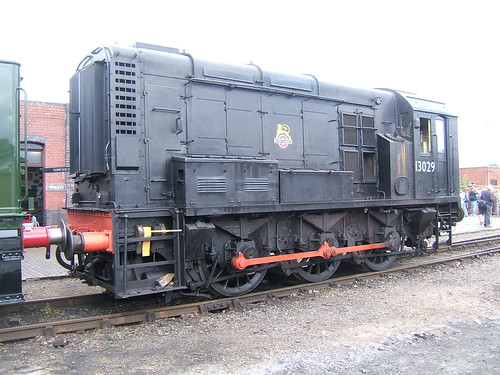I first wrote about Train movements at Yangon Central station in the post here. The station is controlled from a miniature lever Westinghouse power frame which I described in a post here.
All Myanmar's trains are operated by various diesel locomotives or railcars. Some vehicles are now quite elderly, although there are increasing numbers of new Chinese-built 2,000 h.p. diesel electric locomotives. There's an outline of the locomotive classes in the post Diesel Traction in Burma whilst diesel railcars and multiple-units are shown in Diesel Railcars in Burma. Both of these posts need updating (in particular the railcar post from 2013 which only hints, in the section 'Recent Developments', at the influx of second-hand re-gauged Japanese multiple units which have eliminated some locomotive-hauled workings around Yangon).

Yangon Central Station 1-Oct-2017: The tantalising view from my hotel room on the 21st floor of the Sule Shanri-La.
Train movements on Sunday 1st October 2017
There's a fairly non-technical description of the day here. Whilst I was on the roadbridge at the west end of Yangon Central Station (taking pictures before continuing to the station itself), a Japanese diesel multiple unit (RBE25109 leading but multipled to, I think, 8 coaches) departed heading west.
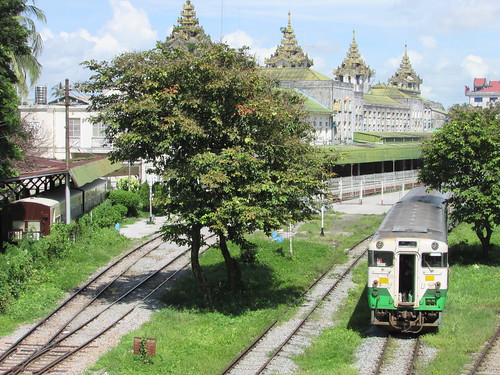
Second-hand Japanese DMU leaves platform 4 heading west with the post-war 'Burmese-style' station building in the rear.
My vantage point on the road bridge also showed DF.1622 (as I later confirmed) stood at the eastern end of four coaches (all in green and blue livery) standing at the eastern end of platform 6 for a long time. DF.1200.03 was standing in the west end of platform 7, attached to a bogie goods van. One of the hard-working 900 horse power units had arrived with a local train from the east in platform 7 East and it had soon uncoupled from its train and crossed onto the Through line, ready to run round its train.
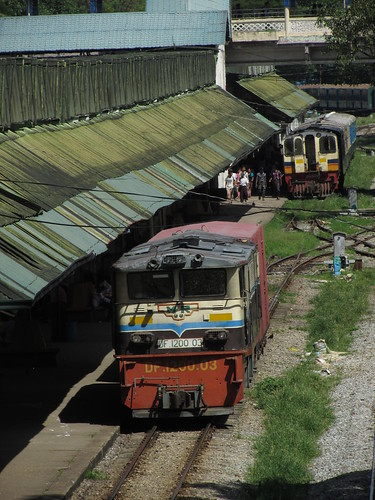
Yangon Central Station: DF.1200.03 standing in the west end of platform 7, with bogie goods van and unidentified 900 horse power loco with a local train from the east in platform 7.
Another unidentified Bo-Bo-Bo arrived from the west with its train and headed to the unoccupied platform 5. I then continued my walk to the station, recording the Japanese signalling modernisation and taking pictures of train movements for around 90 minutes. The pictures taken on Sunday are in the collection Yangon Central Station (2).
Train movements on Monday 2nd October 2017
There's a fairly non-technical description of the day here. In the late afternoon, I walked to the station where I observed the train movements during the afternoon 'rush' for around an hour.
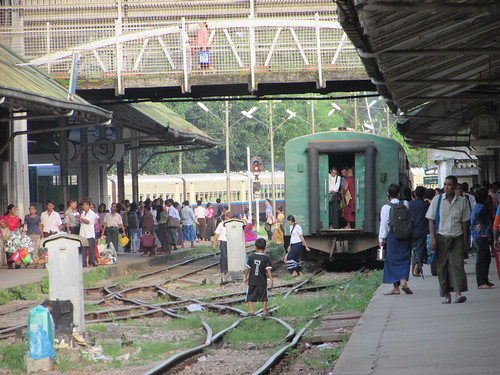
Yangon Central Station: View from platform 6, looking east.
 Yangon Central Station: Building-up the 'knuckle' of an automatic coupler with electric welding in the carriage sidings to the south of the station.
Yangon Central Station: Building-up the 'knuckle' of an automatic coupler with electric welding in the carriage sidings to the south of the station.
Train movements on Tuesday 3rd October 2017
There's a fairly non-technical description of the day here. Whilst taking breakfast, I made a few notes about movements at the west end of the station:-
07:10 DF 1200-class (perhaps) in Red/cream arrives from the west with a goods van and 2 black (?) coaches, onto goods avoiding line.
07:25 Co-Co (brown/cream) from plat 1 to north siding.
07:30 4-car DMU green/cream arrives from west.
07:40 Bo Bo Bo red/blue arrives from east into 5 (?) with passenger train.
07:50 Bo Bo Bo red/blue arrives into 4 (?) from west with 10-coach train, all modern, pale green.
07:55 Bo Bo Bo red/blue LE off 07:40 arrival heads into north siding, stops, proceeds further then heads east on goods avoiding line.
I visited the station in the late afternoon when there is plenty of train movement.

Yangon Central Station: 3-Oct-2017: Three trains moving at the east end.
The movements I monitored are listed in the table below. Click on 'Photo' ref to view the associated picture. Use 'back button' (not the 'Back to photostream' button) to return to this post.
| Time | Notes | Photo |
| 16:56 | DF.1238 arriving in platform 7 with a local from the east. | 6913 |
| 16:57 | DF.1238 uncouples and draws onto the 'Through' (road 8) prior to running round. | 6914 |
| 16:59 | DF.1220 crossing via scissors from plat 5 to plat 6, heading east. | 6916 |
| 17:04 | Eastbound departures in platforms 6 (DF.1220) and 7 (DF.1238), DMU leaving on Up Main in background. | 6924 |
| 17:05 | Fuzzy shot of Train Number 3, 17:00 departure 5 minutes late hauled by Chinese Bo-Bo-Bo. Train has Upper Class Sleeping, Upper Class, Ordinary Class and a Restaurent, due Mandalay 07:45 following morning. | 6925 |
| 17:06 | Bo-Bo-Bo departs from 6 as a Japanese DMU RBE25127 (with red headlamps) arrives on 8 (Through). | 6927 |
| 17:07 | Japanese DMU in 5 with DD522 Kawasaki station pilot, flat car for shunters and Bo-Bo-Bo DF1264 in 3. | 6928 |
| 17:07 | DF1238 leaving 7 as RBE 25127 awaits access to 7 | 6929 |
| 17:08 | DF2082 arriving with Down train (possibly train 32, 08:00 from Naypyitaw). | 6931 |
| 17:13 | Three trains moving at the east end (L-R) Japanese DMU departs east from 4, Japanese DMU also departs east from 5, whilst a Bo-Bo-Bo propels coaches into the carriage sidings. | 6937 |
| 17:16 | DF1264, with shunters flat car heads east from platform 3. | 6940 |
| 17:18 | DD522 takes empty coaches east. | 6942 |
| 17:25 | Yangon Central Station: 3-Oct-2017 Japanese DMU arriving in platform 5 from west. | 6947 |
| 17:26 | Bo-Bo-Bo about to leave platform 7 heading east with a passenger train. | 6948 |
| 17:28 | As a 900 hp arrives with 6 coaches with matching advertising logos (probably from Insein) a Bo-Bo-Bo heads east with a short train and many hangers-on. | 6950 |
| 17:28 | Yangon Central Station: 3-Oct-2017 DF1255 arriving in platform 7 from the west. A Japanese DMU stands in platform 6 West. | 6951 |
| 17:28 | Station Pilot propels empty stock into the carriage sidings. | 6952 |
| 17:32 | DF1246 arriving in platform 6 from the east with DF1255 in 7 waiting for the road. | 6959 |
| 17:34 | Yangon Central Station: 3-Oct-2017 DF1255 leaves platform 7 heading east. | 6963 |
| 17:41 | DF1248 runs round and couples-up ready to head back east at 17:43. | 6967 |
| 17:45 | DF2082 (which earlier brought in the train from Naypyitaw) appears light heading east on platform 5 and stops. | 6974 |
| 17:47 | DF1330 arrives with Train 90, 08:00 ex-Mawlamyine. | 6977 |
| 17:51 | DF1259 arrives in platform 7 from the west. | 6981 |
| 17:56 | DF2082 still awaits the road as an unidentified train departs eastwards. | 6987 |
But don't ask about the coaches plastered with EU logos.
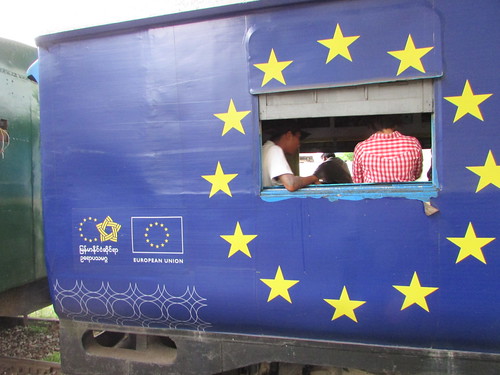
Yangon Central Station: 3-Oct-2017: Some elderly coaches are 'improved' by EU vinyls.
Related Posts on this Website
There are a number of posts describing Myanma Railways and my previous visits to Yangon Central station. You can find them all here or there's an Index (with links) here.
My Pictures
Railway pictures taken on 1st, 2nd and 3rd October referred to above form part of the collection Yangon Central Station (2).
All my pictures of Myanma Railways, including the Circle Line, are here.
Photographs may be selected, viewed or downloaded, in various sizes.
